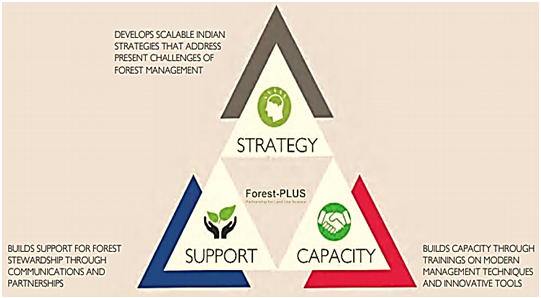Forest-PLUS 2.0 Programme
- 30 Sep 2019
- Recently, India's Ministry of Environment, Forest and Climate Change (MoEF&CC) in collaboration with the US Agency for International Development (USAID) launched the Forest-PLUS 2.0 programme.
- It is the second set of pilot projects, is meant to enhance sustainable forest landscape management after Forest-PLUS completed its five years in 2017.
Aim
- It aims to reduce emissions from deforestation and forest degradation and enhance sequestration through afforestation, conservation, and sustainable management of
Need for Forest-Plus Programme
- India has communicated in its Nationally Determined Contribution (NDC) under Paris Agreement (2015)to capture 2.5 to 3 billion tonnes of Carbon dioxide through additional forest and tree cover by 2030.
Key Actions under Forest 2.0
To Develop Tools for Managing Forests for Multiple Services:
- Under the project, forestry management tools to enhance the flow of ecosystem services (water, in particular) will be developed in addition to development of model forest management plans based on an established ecosystem approach.
- It help respond to increasing recognition of the need to manage forested watersheds to enhance water flow and quality, and improve the livelihood opportunities and resilience of forest-dependent communities.
Market-Based Instruments for Enhancing Finance:
- The program will develop tools to better monitor and value ecosystem services, and will also demonstrate market-based mechanisms for efficient delivery of these services.
- For example, a municipality or industry would make payments to upstream forest communities for using water flowing down from the forests because of improved forest management.
Conservation along Economic Opportunities:
- USAID will focus on modeling and setting up conservation enterprises to provide viable economic opportunities to forest-dependent people (rather than subsistence-scale livelihoods) and will leverage considerable investment by the private sector.
Target Area for Forest-Plus 2.0
- It comprises pilot project in three landscapes — Gaya in Bihar, Thiruvananthapuram in Kerala and Medak in Telangana.
- The choice of these sites was driven by the contrast in their landscapes – Bihar is a forest deficit area, Telangana is a relatively drier area where there is ample scope for community livelihood enhancement and Kerala is rich in biodiversity.
Targets to be achieved
- 1,20,000 hectares of land under improved management
- New, inclusive economic activity worth $12 million
- Measurable benefits accrued to 800,000 households
- Three incentive mechanisms( Strategy, Capacity and Support) demonstrated in managing landscapes for ecosystem services

Source: USAID
Forest-Plus (Partnership for Land Use Science)
Reducing Emissions from Deforestation and forest Degradation (REDD+)
|
Significance
- Maintaining Ecosystem Health: Over the past few years, ithas helped target households reduce fuel wood use by almost 50 percent and improve management of about 1 million hectares of forests.
- Enhanced Forest Monitoring:The project has helped the Government of India to develop a robust forest carbon monitoring system so that it can participate in the global forest carbon market.
- Securing Livelihoods of Weaker Sections:The project has contributed to the betterment of the vulnerable USAID works with poor and marginalized forest communities in some of the remotest regions of India. For ex. in the Koraput district of Odisha, community members learned new skills for the sustainable harvest and processing of non-timber forest products. Then they invested in five women-led producer companies, boosting incomes for 4,000 families by 40 percent.
- Innovative Private-sector Engagement: It has brought together local communities, government agencies, civil society groups, and the private sector for afforestation activities. This model enables the private sector to provide timely and effective inputs for forest management. Because India’s current forest policy framework does not include roles for private sector in all aspects of forest management, this partnership model will enable the private sector to scale-up its vital engagement in forest management within the current policy constraints.
Way Forward
- Increased pressure on forest resources of the country over the last few decades has threatened the livelihoods of millions of forest-dwellers and other poor people living in the vicinity of the forests. Forest resources have been important for the prosperity of any nation and its communities.
- They are an essential natural resource providing multiple benefits to people besides other important functions such as biodiversity conservation, global carbon storage and a storehouse for future option values. The richand the poor alike are dependent on forest resources, directly or indirectly, and forestry in many developing countries, including India is also seen as a means for eradicating rural poverty and achieving sustainable development goal (SDG).




